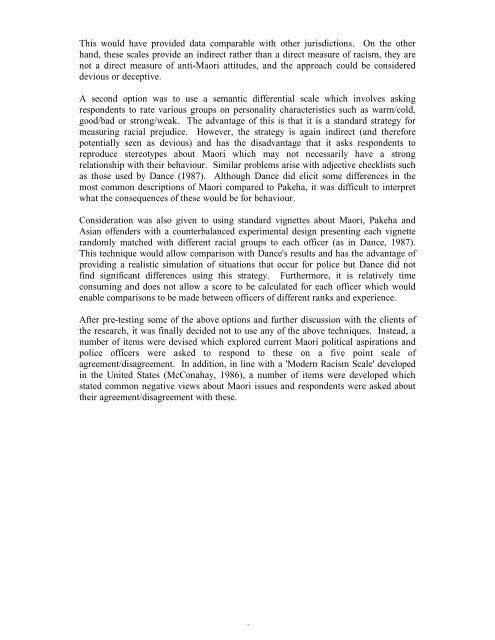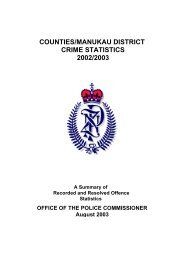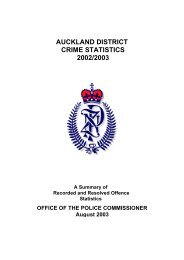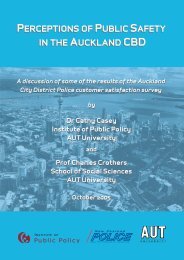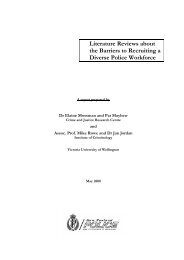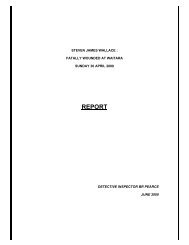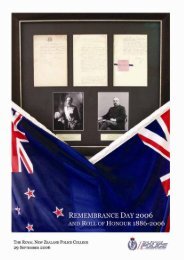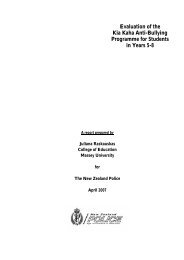Police Perceptions of Maori - Rethinking Crime and Punishment
Police Perceptions of Maori - Rethinking Crime and Punishment
Police Perceptions of Maori - Rethinking Crime and Punishment
Create successful ePaper yourself
Turn your PDF publications into a flip-book with our unique Google optimized e-Paper software.
This would have provided data comparable with other jurisdictions. On the other<br />
h<strong>and</strong>, these scales provide an indirect rather than a direct measure <strong>of</strong> racism, they are<br />
not a direct measure <strong>of</strong> anti-<strong>Maori</strong> attitudes, <strong>and</strong> the approach could be considered<br />
devious or deceptive.<br />
A second option was to use a semantic differential scale which involves asking<br />
respondents to rate various groups on personality characteristics such as warm/cold,<br />
good/bad or strong/weak. The advantage <strong>of</strong> this is that it is a st<strong>and</strong>ard strategy for<br />
measuring racial prejudice. However, the strategy is again indirect (<strong>and</strong> therefore<br />
potentially seen as devious) <strong>and</strong> has the disadvantage that it asks respondents to<br />
reproduce stereotypes about <strong>Maori</strong> which may not necessarily have a strong<br />
relationship with their behaviour. Similar problems arise with adjective checklists such<br />
as those used by Dance (1987). Although Dance did elicit some differences in the<br />
most common descriptions <strong>of</strong> <strong>Maori</strong> compared to Pakeha, it was difficult to interpret<br />
what the consequences <strong>of</strong> these would be for behaviour.<br />
Consideration was also given to using st<strong>and</strong>ard vignettes about <strong>Maori</strong>, Pakeha <strong>and</strong><br />
Asian <strong>of</strong>fenders with a counterbalanced experimental design presenting each vignette<br />
r<strong>and</strong>omly matched with different racial groups to each <strong>of</strong>ficer (as in Dance, 1987).<br />
This technique would allow comparison with Dance's results <strong>and</strong> has the advantage <strong>of</strong><br />
providing a realistic simulation <strong>of</strong> situations that occur for police but Dance did not<br />
find significant differences using this strategy. Furthermore, it is relatively time<br />
consuming <strong>and</strong> does not allow a score to be calculated for each <strong>of</strong>ficer which would<br />
enable comparisons to be made between <strong>of</strong>ficers <strong>of</strong> different ranks <strong>and</strong> experience.<br />
After pre-testing some <strong>of</strong> the above options <strong>and</strong> further discussion with the clients <strong>of</strong><br />
the research, it was finally decided not to use any <strong>of</strong> the above techniques. Instead, a<br />
number <strong>of</strong> items were devised which explored current <strong>Maori</strong> political aspirations <strong>and</strong><br />
police <strong>of</strong>ficers were asked to respond to these on a five point scale <strong>of</strong><br />
agreement/disagreement. In addition, in line with a 'Modern Racism Scale' developed<br />
in the United States (McConahay, 1986), a number <strong>of</strong> items were developed which<br />
stated common negative views about <strong>Maori</strong> issues <strong>and</strong> respondents were asked about<br />
their agreement/disagreement with these.<br />
4


